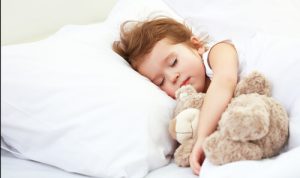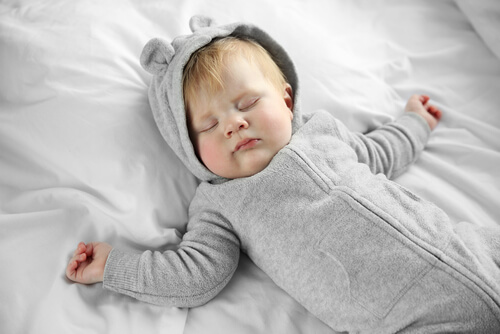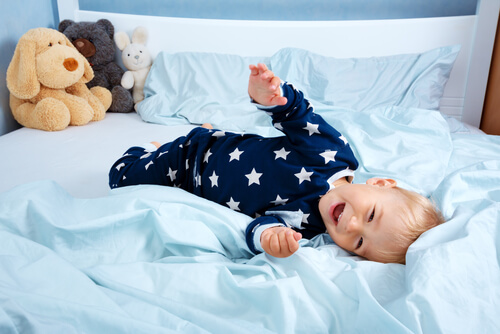From Crib to Bed with No Tears: Sleeping Alone Can Be Easy

Going from a crib to a bed without any tears or tantrums is easy – when your child gets into your bed. However, getting children to start sleeping alone in their own room all night can be much more difficult.
You may have several concerns at first. What if they fall out of bed? Are they afraid of the dark?
Maybe they don’t like sleeping alone? Perhaps they’re still too young. They might be lonely…
The first thing we should keep in mind is that most of these fears are unfounded. Most of the time, it’s the parents who worry about children sleeping alone.
Unfortunately, they tend to pass on their concern to their child.
When to change from a crib to a bed
There is no one right moment or age to make this change. It’s a good idea for your child to be sleeping alone by their second birthday, however. Otherwise, sharing your bedroom will turn into a habit that is hard to break.
Parents should listen to their own instincts, but avoid giving credit to fears that are out of proportion. Remember, children are often more independent than we think.
Parents normally take advantage of the moment when their child no longer fits in their crib to get them their own bed. This is an excellent excuse for children to begin sleeping alone.
For your own peace of mind, you can put up protective rails so your child won’t fall out of their new bed. These are also useful to hang onto while getting into bed, or getting out to go to the bathroom during the night.

It’s not a good idea to make this transition just as a new baby arrives. If this happens, your child may feel like they’re being replaced. This can lead to tantrums, jealousy or simply sadness.
In these cases, it’s best to get your toddler into a routine of sleeping alone a few months before the new baby is born. This way, your older child won’t relate the change to the new baby.
If this isn’t your first child, however, they may take the lead. They might even ask you for a bed of their own. Younger siblings often want to feel like big kids and imitate their older brothers or sisters.
Adapting to sleeping alone
Every child in the world is unique. There are children who see sleeping alone as a big achievement, and others who perceive it as a punishment. However, you can help to make sure your child feels positive about sleeping in their own bed.
Here are things you can do to ensure that the transition from crib to bed is as smooth as possible:
- “You’re such a big girl!” “You’re a big boy now!” Kids want to grow as quickly as possible and love to be seen as big or grown up. The best thing we can do to help them start sleeping alone in their own bed is to tell them they’re too big for a crib. If we help them believe that sleeping alone is an achievement, they’ll enjoy the new experience. For example, if your child has picked up all their toys or behaved particularly well, you could say “since you’ve been so good today, you can sleep in your bed all night long.” This way, your child will see sleeping in their bed as a reward.

- Associate their bed with fun activities. Another technique is to link the new bed to an activity that the child enjoys. Read a story just before they go to sleep, sing them a song they like, play for a few minutes with the stuffed animals they sleep with or tell them something funny. In this way, your child will begin to see their bed as something familiar and fun.
- Make it personal. Another good way to get children used to their new bed and bedroom is to take them to choose sheets, pillows, the comforter, curtains and some stuffed animals. Make sure the child is there while you decorate their room. This way, they’ll begin to see their room as a nice place where they like spending time. Personalizing their room will also stop them from being scared at night, since they’ll know they’re surrounded by their favorite toys.
As you can see, children at this age are easy to persuade. Let them know how proud of them you are for sleeping alone in their own bed, and they will see this as something they want to do.
All cited sources were thoroughly reviewed by our team to ensure their quality, reliability, currency, and validity. The bibliography of this article was considered reliable and of academic or scientific accuracy.
- Cobos, F. J. M. (1998). Resistencia a irse solo a la cama: estudio de caso. Revista de Psicopatología y Psicología Clínica, 3(2), 139-144. http://revistas.uned.es/index.php/RPPC/article/view/3862/3717
- Roncal Paucar, G. J., Santa Cruz Pardo, J. A., & Villanueva Bytton, S. J. Cuna multifuncional. https://repositorioacademico.upc.edu.pe/handle/10757/653277
This text is provided for informational purposes only and does not replace consultation with a professional. If in doubt, consult your specialist.








